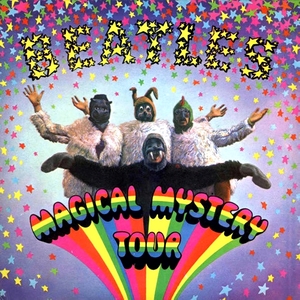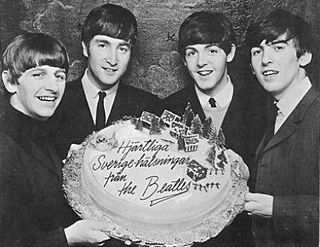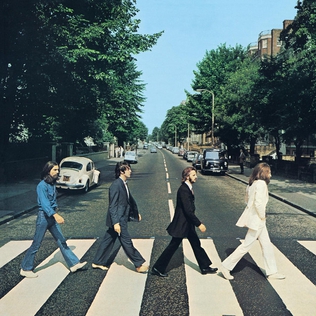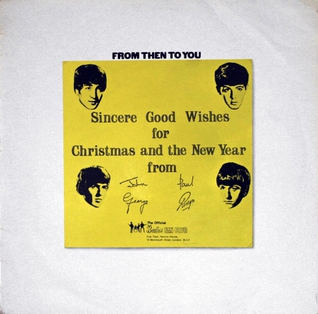Abbey Road most commonly refers to the eleventh studio album by The Beatles.
Abbey Road may also refer to:

The Beatles were an English rock band, formed in Liverpool in 1960, that comprised John Lennon, Paul McCartney, George Harrison and Ringo Starr. They are regarded as the most influential band of all time and were integral to the development of 1960s counterculture and popular music's recognition as an art form. Rooted in skiffle, beat and 1950s rock 'n' roll, their sound incorporated elements of classical music and traditional pop in innovative ways; the band also explored music styles ranging from folk and Indian music to psychedelia and hard rock. As pioneers in recording, songwriting and artistic presentation, the Beatles revolutionised many aspects of the music industry and were often publicised as leaders of the era's youth and sociocultural movements.

St John's Wood is a district in the City of Westminster, London, lying 2.5 miles (4 km) northwest of Charing Cross. Traditionally the northern part of the ancient parish and Metropolitan Borough of Marylebone, it extends east to west from Regent's Park and Primrose Hill to Edgware Road, with the Swiss Cottage area of Hampstead to the north and Lisson Grove to the south.

Abbey Road Studios is a recording studio at 3 Abbey Road, St John's Wood, City of Westminster, London, England. It was established in November 1931 by the Gramophone Company, a predecessor of British music company EMI, which owned it until Universal Music Group (UMG) took control of part of it in 2013. It is ultimately owned by UMG subsidiary Virgin Records Limited.

Magical Mystery Tour is a record by the English rock band the Beatles that was released as a double EP in the United Kingdom and an LP in the United States. It includes the soundtrack to the 1967 television film of the same name. The EP was issued in the UK on 8 December 1967 on the Parlophone label, while the Capitol Records LP release in the US and Canada occurred on 27 November and features an additional five songs that were originally released as singles that year. In 1976, Parlophone released the eleven-track LP in the UK.

1 is a compilation album of the English rock band the Beatles, originally released on 13 November 2000. The album features virtually every number-one single the band achieved in the United Kingdom or United States from 1962 to 1970. Issued on the 30th anniversary of the band's break-up, it was their first compilation available on only one CD. 1 was a commercial success and topped charts worldwide. It has sold over 31 million copies.

Worldwide, the English rock band the Beatles released 12 studio albums, 6 live albums, 54 compilation albums, 36 extended plays (EPs), 63 singles, 17 box sets, 22 video albums and 68 music videos. In their native United Kingdom, they released 12 studio albums, 13 extended plays (EPs), including one double EP, and 22 singles. The early albums and singles released from 1962 to 1967 were originally on Parlophone, and their albums and singles from 1968 to 1970 were on their subsidiary label Apple. Their output also includes vault items, remixed mash-ups and anniversary box-sets.
A revolution is a drastic political change that usually occurs relatively quickly. For revolutions which affect society, culture, and technology more than political systems, see social revolution.

"Something" is a song by the English rock band the Beatles from their 1969 album Abbey Road. It was written by George Harrison, the band's lead guitarist. Together with his second contribution to Abbey Road, "Here Comes the Sun", it is widely viewed by music historians as having marked Harrison's ascendancy as a composer to the level of the Beatles' principal songwriters, John Lennon and Paul McCartney. Two weeks after the album's release, the song was issued on a double A-side single, coupled with "Come Together", making it the first Harrison composition to become a Beatles A-side. The pairing was also the first time in the United Kingdom that the Beatles issued a single containing tracks already available on an album. While the single's commercial performance was lessened by this, it topped the Billboard Hot 100 in the United States as well as charts in Australia, Canada, New Zealand and West Germany, and peaked at number 4 in the UK.

Abbey Road is the eleventh studio album released by the English rock band the Beatles. It is the last album the group started recording, although Let It Be was the last album completed before the band's break-up in April 1970. It was mostly recorded in April, July and August 1969, and was released on 26 September 1969 in the United Kingdom, and 1 October 1969 in the United States, reaching number one in both countries. A double A-side single from the album, "Something" / "Come Together" was released in October, which also topped the charts in the US.

"Here Comes the Sun" is a song by the English rock band the Beatles from their 1969 album Abbey Road. It was written by George Harrison and is one of his best-known compositions. Harrison wrote the song in early 1969 at the country house of his friend Eric Clapton, where Harrison had chosen to play truant for the day to avoid attending a meeting at the Beatles' Apple Corps organisation. The lyrics reflect his relief at the arrival of spring and the temporary respite he was experiencing from the band's business affairs.
"Polythene Pam" is a song by the British rock band the Beatles from their 1969 album Abbey Road. Written by John Lennon and credited to Lennon–McCartney, it is the fourth song of the album's climactic side-two medley. The Beatles recorded the track in July 1969 as a continuous piece with "She Came In Through the Bathroom Window", which follows it in the medley.

"Blue Jay Way" is a song by the English rock band the Beatles. Written by George Harrison, it was released in 1967 on the group's Magical Mystery Tour EP and album. The song was named after a street in the Hollywood Hills of Los Angeles where Harrison stayed in August 1967, shortly before visiting the Haight-Ashbury district of San Francisco. The lyrics document Harrison's wait for music publicist Derek Taylor to find his way to Blue Jay Way through the fog-ridden hills, while Harrison struggled to stay awake after the flight from London to Los Angeles.

From December 1963 to December 1969, English rock group the Beatles sent out spoken and musical messages on flexi disc to members of their official fan clubs in the United Kingdom (UK) and the United States (US) each Christmas. An LP compilation of all seven, titled From Then to You in the UK and The Beatles Christmas Album in the US, was sent out in 1970.

"Maggie May" is a traditional Liverpool folk song about a prostitute who robbed a "homeward bounder": a sailor coming home from a round trip.
The Apple scruffs were a group of devoted Beatles fans who congregated outside the Apple Corps building and at the gates of Abbey Road Studios in London during the late 1960s, in the hope of seeing or interacting with one of the band members. The name was coined by George Harrison. According to Apple press officer Derek Taylor, when The Sunday Times wrote a feature article on the company in the late 1960s, their map included a location for the scruffs, on the steps of the offices at 3 Savile Row.

Abbey Road DLR station is a Docklands Light Railway station in West Ham in the London Borough of Newham, in east London, England. It is located on the Stratford International extension of the Docklands Light Railway.

The Beatles in Mono is a boxed set compilation comprising the remastered monaural recordings by the Beatles. The set was released on compact disc on 9 September 2009, the same day the remastered stereo recordings and companion The Beatles were also released, along with The Beatles: Rock Band video game. The remastering project for both mono and stereo versions was led by EMI senior studio engineers Allan Rouse and Guy Massey. The release date of 09/09/09 is related to the significance to John Lennon of the number nine.
This is a summary of 1969 in music in the United Kingdom.
Furness Abbey is a former railway station in the Barrow-in-Furness area of the Furness Peninsula, England.